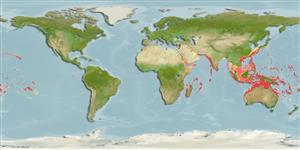分类 / Names
俗名 | 同种异名 | Catalog of Fishes(属, 种) | ITIS | CoL | WoRMS | Cloffa
Teleostei >
Acanthuriformes (Surgeonfishes)
鱸形目 (Surgeonfishes) >
Acanthuridae (Surgeonfishes, tangs, unicornfishes)
刺尾鯛科 (Surgeonfishes, tangs, unicornfishes) > Nasinae
Etymology: Naso: Latin, nasus = nose (Ref. 45335).
More on author: Forsskål.
Environment: milieu / climate zone / depth range / distribution range
生态学
海洋 礁区鱼类; 深度上下限 0 - 180 m (Ref. 89972). 热带; 26°C - 29°C (Ref. 27115); 35°N - 33°S, 30°E - 128°W
Indo-Pacific: Red Sea and East Africa (Ref. 3145) to the Hawaiian, Marquesas and Tuamoto islands, north to southern Japan, south to Lord Howe and Rapa islands. Presence in Somalia to be confirmed (Ref. 30573).
印度-太平洋: 红海与东非 (参考文献 3145) 到夏威夷, 马可萨斯岛与 Tuamoto 岛, 北至日本南部, 南至罗得豪岛与拉帕群岛。 在索马利亚中的出现被确认.(参考文献 30573)
大小 / 重量 / 年龄
Maturity: Lm ? range ? - ? cm
Max length : 70.0 cm FL 雄鱼/尚未辨别雌雄; (Ref. 9710); common length : 50.0 cm TL 雄鱼/尚未辨别雌雄; (Ref. 3146); 最大年龄: 55 年 (Ref. 118238)
背棘 (总数) : 6; 背的软条 (总数) : 27 - 30; 臀棘: 2; 臀鳍软条: 27 - 30. This species is characterized by the following: body depth vary from about 2.0 in SL (in subadults) to 2.4-2.6 (adults) in SL; with a tapering, bony, horn on forehead of adults projecting anteriorly at level of eye but not extending in front of mouth (horn first as a bump on forehead at a length of about 12 cm); dorsal profile from snout to horn straight, angle of about 45°; 2 peduncular plates with well-developed forward-curving knife-like spines; emarginate caudal fin when young, truncate with filamentous lobes in adult; males apparently with longer horn, larger peduncular keels and longer caudal filaments than females of the same size; body yellowish to olivaceous gray dorsally, paler ventrally, with blue peduncular plates and keel spines; lips whitish or blue; blue area is sometimes present around pectoral fin; dorsal and anal fins yellowish with narrow blue margins; caudal fin orangish basally, shading to gray, with a broad, pale greenish posterior border and caudal filaments are edged in blue; one transient color phase is a blotchy pale greenish zone below the spinous portion of dorsal fin that narrows and ends beneath the pectoral fin (Ref. 27362).
出现一个触角或喙。 两个尾叶延长到丝状突起内了。 雄性成鱼超过相同的大小的雌性倾向有较好的发展的角质又肉梗的棘 , 与尾丝。 尾鳍
Adults inhabit channels, moats, lagoon and seaward reefs with strong surge (Ref. 48637). Benthopelagic (Ref. 58302). Typically occurring in small groups. Sometimes solitary (Ref. 90102). Juveniles in shallow protected bays and harbours (Ref. 48637). Mainly diurnal, feed on coarse leafy brown algae like Sargassum. Pair-spawning has been observed. Minimum depth reported taken from Ref. 128797.
栖息于峡道,壕沟,舄湖与临海礁石具有强烈波涛的。 典型地出现在小群鱼群。 稚鱼在水浅且有遮蔽的海湾与港口。 (参考文献 48637) 主要日行性, 它吃粗糙多叶的褐色藻类例如马尾藻 . 成对产卵已经被观察。
Life cycle and mating behavior
Maturities | 繁殖 | Spawnings | Egg(s) | Fecundities | 仔鱼
Spawn in pairs (Ref. 240).印度-太平洋: 红海与东非 (参考文献 3145) 到夏威夷, 马可萨斯岛与 Tuamoto 岛, 北至日本南部, 南至罗得豪岛与拉帕群岛。 在索马利亚中的出现被确认.(参考文献 30573)
Myers, R.F., 1991. Micronesian reef fishes. Second Ed. Coral Graphics, Barrigada, Guam. 298 p. (Ref. 1602)
人类利用
渔业: 商业性; 游钓鱼种: 是的; 水族馆: 商业性
工具
特别资料
下载 XML
网络资源
Estimates based on models
Preferred temperature (Ref.
123201): 23.4 - 28.8, mean 27.4 °C (based on 1536 cells).
Phylogenetic diversity index (Ref.
82804): PD
50 = 0.5000 [Uniqueness, from 0.5 = low to 2.0 = high].
Bayesian length-weight: a=0.02344 (0.01735 - 0.03168), b=2.95 (2.86 - 3.04), in cm total length, based on LWR estimates for this species (Ref.
93245).
营养阶层 (Ref.
69278): 2.2 ±0.11 se; based on food items.
回复力 (Ref.
120179): 低的, 最小族群倍增时间4.5 - 14 年 (K=0.14).
Prior r = 0.28, 95% CL = 0.18 - 0.42, Based on 3 data-limited stock assessments.
Fishing Vulnerability (Ref.
59153): Low to moderate vulnerability (32 of 100).
Climate Vulnerability (Ref.
125649): Very high vulnerability (80 of 100).
Nutrients (Ref.
124155): Calcium = 33.3 [16.8, 58.2] mg/100g; Iron = 0.554 [0.285, 1.039] mg/100g; Protein = 18.4 [17.1, 19.7] %; Omega3 = 0.109 [0.065, 0.196] g/100g; Selenium = 58.8 [29.8, 118.5] μg/100g; VitaminA = 21.5 [5.0, 90.1] μg/100g; Zinc = 1.03 [0.66, 1.54] mg/100g (wet weight);
